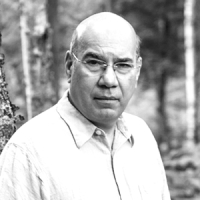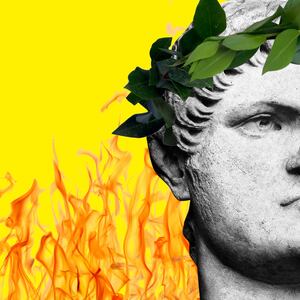During the past decade, if not before, I’ve been wrestling with an angel: Paul the Apostle. I’ve been reading the letters of Paul intensely from the time I was a young man, drawn by his wild and visionary sense of reality, his “invention” of Christianity, his example as a man who moved through the wide cosmopolitan world of the first century without the slightest fear of consequences. (In this, he’s very different from me and, I suspect, most of us!) As Easter approaches, I begin to think about what Paul said when he urged us to “take on the mind of Christ” [Philippians 2.5], which in his theology means entering completely into this cosmic spirit so that the spirit itself becomes part of us.
My own spiritual journey has been a textual one in part, living in the gospels and letters of Paul as a reader, digging into the Greek words themselves to unearth their full meaning. This work, most recently, has led to a series of 21 lectures that I recorded some months ago about Jesus, Paul, and the early Christians. And I have just published The Damascus Road: A Novel of Saint Paul.
In this novel, I write as Paul in the first person, countering or “correcting” his narrative with that of his traveling companion, Luke, who wrote the Gospel of Luke and, of course, the Acts of the Apostles, the latter being an account of their missionary journeys through the Roman world—a journey that ended with the martyrdom of Paul in Rome around the time of the great fire of 64 A.C.E. Luke’s cool-headed view of what was happening stands (at least in my novel) in contrast to Paul’s mad visionary rhetoric, as embodied in his letters.
ADVERTISEMENT
To write this, I had to sink into the physical as well as mental geography of these men, traveling to the Holy Lands (what I call Palestine in the novel, as all of this region was called in Roman times), to the Jordanian desert, to Asia Minor or what is now Turkey, to Greece and Italy. I followed as best I could in the footsteps of Paul, hoping to summon that world in images, trying at all times to remind myself how these places would have played on the five senses, with its tingling atmosphere of herbs and spices, wild flowers, shit in the streets, decaying bodies, brilliant sunshine on the sea, and evergreen forests as deep as one can imagine.
This was an intellectual journey as well as a physical one. Like Plato, Paul was a founding thinker in the West. In fact, I began to write this novel after reading again through the Dialogues of Plato—always a text I return to for inspiration and bracing mental exercise. I realized how many of Plato’s ideas, even phrases, had sunk into Paul’s unconscious. He casually quotes from the great philosopher throughout his letters. The very idea of the eternal soul was, of course, illumined by Plato, and Paul ran with this, creating a Platonic theology.
It’s important to recall that Paul was a Greek-speaking Jew, born in Tarsus (now in Turkey), privately educated there by Greek-influenced tutors—the latter is an assumption, but one that seems to make sense, given his erudition, his command of Greek prose, his range of allusion. His status as one of the elite is evident in the fact that he “transferred” to the academy run by Gamaliel in Jerusalem as a young man. Only the child of a wealthy family would have been shipped to a far-off country to study under a major scholar like Gamaliel, the grandson of Hillel—the famous Jewish sage.
But what mostly drew me to Paul was his vision of equality—not what one usually thinks about when one thinks of Paul. Indeed, many friends who heard I was writing about Paul raised an eyebrow or two, saying: Wasn’t he a patriarchal misogynist who hated all gays?
My answer, invariably, was No! No! No!
Paul’s chief idea was this, as found in Galatians 3:28: “In Christ there is neither Jew nor Gentile, neither slave nor free man, neither male nor female. In Christ, all of these are one.” For me, this is the key verse in the entire New Testament.
Boldly, Paul erased the most crucial barriers of his day. Himself a Jew, a member of the tribe of Benjamin, a Pharisee by affiliation, he took the Good News (as he called it) to the West, understanding that if the Way of Jesus were to prosper, it would have to go beyond this powerful boundary. In this, he fought against the church in Jerusalem, led by James, the brother of Jesus, who wished only for the Way to remain a kind of hyper-Jewish sect devoted to the strict adherence to the Law of Moses. Had James won out over Paul, Christianity would soon have dwindled to a tiny group in the Holy Land, one that would soon be overridden, obliterated by time and circumstances.
Needless to say, Paul challenged class divisions when he erased the boundaries between slave and free man. Remember that half of the people one met in the ancient world were slaves. Paul would have grown up with a houseful full of slaves who fetched water, bought food in the market, cooked and cleaned, raised the children, and so forth. Most of the people working for Paul’s father in his tent-making business in Tarsus would have been slaves. And slaves were invisible, not really people, hardly creatures in possession of a “soul” or—in Greek—psyche. Paul didn’t want to see divisions among the classes, believing that enlightenment (a word I prefer over the less interesting and misleading term “salvation”) would come to everyone in the end, slaves as well as free men and women.
Which brings us, crucially, to men and women. Paul had no doubt that women were equal to men in the sight of God, in the mind of Christ. The world of early Christianity was largely financed and led by women, including the powerful Phoebe, Lydia, and Priscilla. Phoebe is described as a presiding officer in the early movement, a deacon, a dominant figure. She could easily be seen as the first Pope, although there were no such offices as the church was not an official body but a loose aggregation of gatherings with no hard rules or clear theology. Indeed, Paul sent his most important piece of writing, an epistle to the Roman gathering, in the possession of Phoebe, this spirited woman of the world who traveled widely and knew every leader in the early Christian movement.
But what about the patriarchal Paul who said women shouldn’t speak in church? There are two mentions of this, one in the 14th chapter of 1 Corinthians, one in 1 Timothy. The former is widely considered a later addition, an “interpolation” by editors. In this case, the assertion that women should be silent wildly interrupts the flow of the passage, which is whole without it. And the infamous remark is not present in several early manuscripts of this letter. Furthermore, the injunction contradicts the main thrust of the epistle, where (in 1 Corinthians 11:5) Paul says that women should “prophesy and pray” in church. It just makes no logical sense for Paul to follow with a command for them to remain silent: This was an editorial hand at work, much later. And the matter of 1 Timothy is easily discarded as not something written by Paul himself.
Paul only wrote seven letters that survive: Romans, 1 and 2 Corinthians, Galatians, 1 Thessalonians, Philippians, and Philemon. The remaining six letters are “school of Paul,” written much later. To anyone who reads Greek, the difference in prose style is obvious—Garry Wills burrows into this with common sense in What Paul Meant (2006). The differences between the two clumps of letters is profound: They come from wildly different worlds, with different underlying assumptions. A frantic effort was underway on the part of some within the evolving movement to keep the patriarchal practices of Judaism and the Roman world in place. Hence the “pastoral epistles,” 1 and 2 Timothy, which are very late indeed as additions to the New Testament canon.
There is also the complicated matter of Paul’s sexuality. I tend to agree with Bishop John Shelby Spong, a brilliant theologian and church leader, who argues that Paul was “a rigidly controlled gay male,” as he writes in Rescuing the Bible from Fundamentalism (1991). Be this as it may, Paul was clearly at war with his own body, tormented by the idea if not the reality of sexual desire, and eager to withdraw into the company of his male companions: Luke, Timothy, Silas, and others. His conflicted feelings about his own sexual nature may account for the “thorn in his flesh” that he wrote about in his second letter to the church at Corinth. (2 Corinthians 12:7-9)
In my view, the authentic Paul was combative, fiercely intellectual, probably depressive, bi-sexual or gay, a radical visionary who had a fiery image in his head of a new heaven and a new earth. He had a vision of what it meant to take on the full mind of Christ, and this involved emptying himself out thoroughly, taking up the cross, which for him meant following the path of self-abandonment, uniting with the mind of Christ, where everything—male and female, slave and free man, Jew and Gentile—finds reconciliation in unity with God in the eternal moment of Resurrection.







